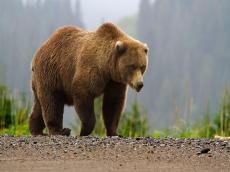Today.Az » Society » Ecology Miinistry continues fight against illegal hunters
27 November 2018 [17:27] - Today.Az

By Azernews
By Narmina Mammadova In the Shahdag National Park, unidentified people killed a bear, the species of which are included in the Red Book of Azerbaijan, the Azerbaijani Ministry of Ecology and Natural Resources reported on November 23. According to the messaget, shots were fired in the 4th district of the Basgal forestry in Ismayilli branch of the Shahdag National Park. The gamekeeper of the regional security service saw six people enter the territory and hunt the brown bear listed in the Red Book of Azerbaijan. The gamekeeper tried to stop the poachers, but, ignoring the legal requirements, they fled the territory. However, the gamekeeper was able to shoot video footage of unknown persons. The video footage was then sent to Ismayilli region police station and presented as material evidence. The fact of the shooting of a brown bear was under investigation. On November 26, six people were detained in the 4th district of Basgal forestry. These were the residents of the Ismayilli and Agsu regions. A hunting rifle and skin of a bear were found. The brown bear is a usual inhabitant of highland forests and rarely appears in lowland forest. It can be found in the upper part of the forest belt, where it eats rich grass stems on glades and meadows, looks for worms, insects and other invertebrates under stones and deadfall. By the end of summer, when bilberry, cherry plum and others ripe, bars come down to forests and stay there till late autumn. They switch to high-caloric food such as acorns, beech nuts and especially chestnut. At this time, bears can go through tens of kilometers. Continent bears eat fish when there is spawning in internal rivers. Other food is not so abundant in the late summer and early autumn, and it is the time when bears can be easily discovered by a hunter because they are more active and spend more time above the forest border to find food necessary for hibernation fat. The first strong snowing of late autumn or early winter pushes them into dens. Healthy and well-fed bears lie in dens in late December which they arrange in caves, hollows and deadfall piles and fall asleep till spring. About 2-3 cubs may be born in a den. In warm and little-snow winters males often ramble and don't fully hibernate because their body temperature doesn't decline. In early spring, bears wake up, full-grown males first. Waking up in spring, bears again have thick and shiny fur. After the 1970s, bear numbers declined in Azerbaijan. Their population increased between 1993 and 2000. According to annual counts carried out by the Ministry of Ecology and Natural Resources of Azerbaijan, there were approximately 1,600 individuals in the country at the time. Habitat destruction and especially illegal hunting have been suggested as major limiting factors for the bear population in Caucasus.
|